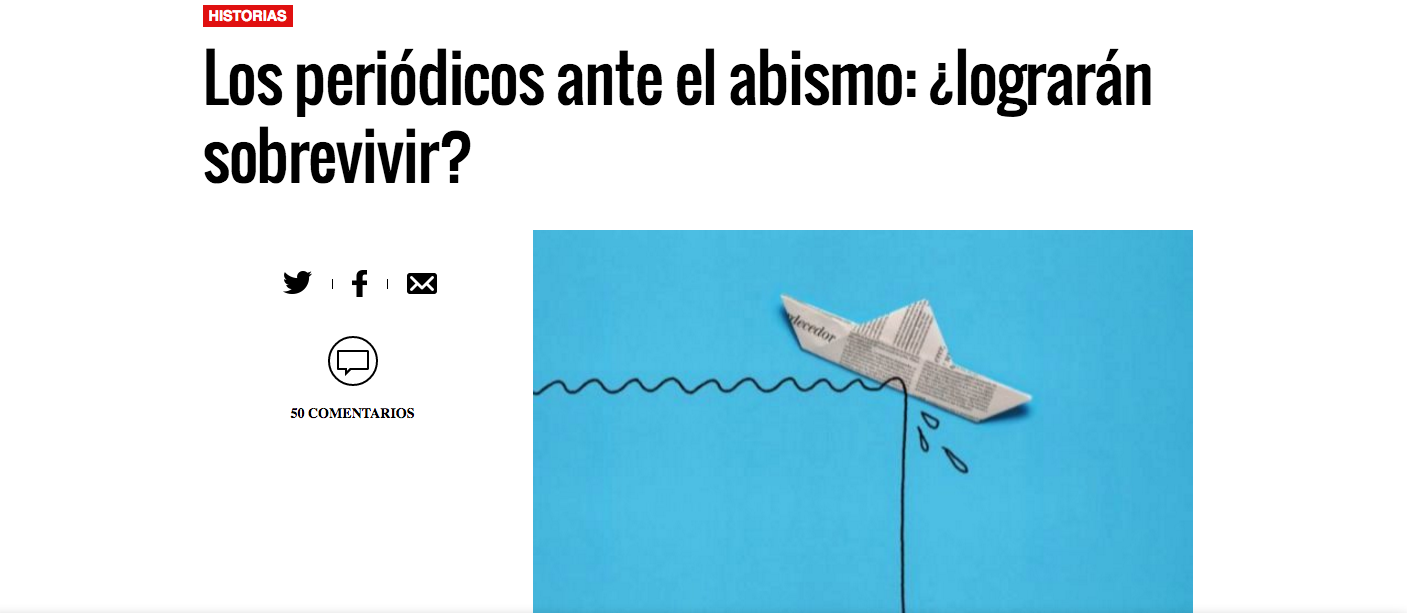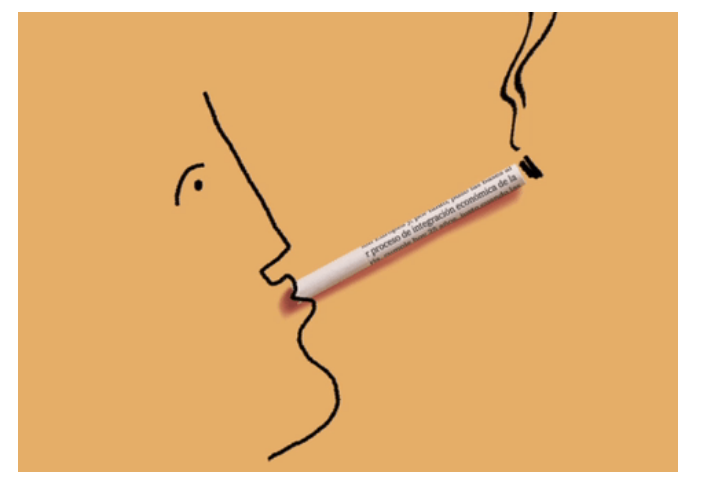A week rarely passes without someone philosophizing about the death of print, the calamities of journalists laid off from newsrooms worldwide, and the reality that advertisers are simply not there in force—and neither are the readers, especially millennials.
I have long ago stopped paying too much attention to such pieces. They rarely contribute anything new, and I can cite four or five cases of articles which predicted that printed newspapers would be gone by 2000, or by 2010. It didn’t happen.
Yet, it is true that printed newspapers are in a state of turmoil and flux, but I would not dismiss them as being in their final days, or in hospice care
Returning to this article in El Mundo, even if you don’t read in Spanish, please go here to see the fantastic animated illustrations by Josetxu L. Pińeiro that accompany it. Here are two of them.


If we go by the numbers, they are grim in Spain for media generally with 375 media companies closing since the economic crisis of 2008.
The article mentions that more than 12000 journalists have lost their jobs.
There has been a loss of 21% of advertising revenues during the third trimester of 2016 in such large media brands as The Wall Street Journal, The Times (UK) and The New York Times.
Yet, while newspapers are seeing gains in the numbers of unique visitors to their websites, the print editions continue to lose circulation. The Association of Daily Newspaper Editors of Spain (AEDE), indicates that in 2016, daily newspaper circulation was 2.149.821. In 2001, it was 4.2 million, representing a drop of more than 50%.
The most thought-provoking quotes
I have translated some quotes of consequence in the El Mundo piece.
Alex Grijelmo, journalist from El Pais:
Newspapers have lost influence because of the popular notion these days that one gets better informed by oneself, via Internet, or social media. We are before the lack of prestige of the media. Yet, in real life we need intermediaries: the doctor, the architect, the butcher. I believe that there will also be a need for the journalism of reflection and prestige, the type that creates a hierarchy for what is real news and that will interpret it with honesty. The news will be coming out of our ears and we will need someone we trust to explain it to us, to tell us why something happens, and what could be the outcome. The alternative to paper is a mare magnum of fake news and real news which we usually access via Google or social media without a sense of hierarchy, its importance, its seriousness. It is unstructured information. If the reader has a structured mind, then no problem. But, if not, it is easy for manipulation to ensue.”
From La Vanguardia’s columnist, Enric Juliana:
Perhaps the printed newspaper is an irreplaceable product: advertising and readers willing to pay for information that is more or less reliable. That dialectic fusion is breaking. Therefore, the question is if there will be newspapers in the future. Not printed newspapers, but newspapers that are printed and digital, with the sufficient editorial strength and political independence to keep maintain a stable community of diverse readers. That is in danger. The public is becoming atomized. Propaganda is winning the battle to information. It is possible that propaganda will win this battle and that journalism will stay behind as minority in a society. It can vaporize as a cultural category. That battle will be fought in the United States in the next four years.
Nacho Escolar, ex editor of Public:
“The digital press is functioning all over the world. It makes money, it grows, it hires new journalists. It is happening in Spain and it is occurring to us at Eldiario.es.
“For me the problem is not so much that we are not generating alternatives, which already exist in the web, but that we in the new media are not capable of occupying the space left vacant by print as it collapses. We imagine the change in the ecosystem of the media as if it were the history of evolution through a fast camera: the paper dinosaurs die, the mammals of the internet are born, and the world continues to spin. But the real risk is that the old media can’t revert their decadence and reinvent new dinosaurs as birds, while the new media can’t seem to grow larger than small squirrels. In this unfinished transformation, it is the citizens who lose.”
The article ends with a statement that resonated with me as an American living in the era of President Trump:
“A recent survey places judges and journalists as the least valued professionals.”
Really? President Trump probably agrees. A scary thought.
Meanwhile, in the UK…..the serendipity of print
I was having an email exchange with my long time friend Jim Jennings, associate publisher of Canada’s The Globe and Mail, and made a reference to the piece I have dissected above about print in Spain. Jim had just returned from a trip to the UK, and I loved what he had to say about print, and definitely agreed with him that those British newspapers still have a lot of fire in them—and the best headline writing!
Here is what Jim told me:
The British press does one thing perhaps better than anyone else in the world. They create a sense of serendipity to the reading experience.
I agree with Jim that it is all about the content and the surprises that those UK newspapers seem to provide daily.
Interwoven with the required fare of Trump; Kim Jong-man; UK troops and battle for Mosul; the first increase in business tax rates in seven years; the status of convictions after errors were discovered in a regional crime lab; the flap in the House of Lord over Brexit; and the prospects of rising food costs post-Brexit. You’ll find the offbeat . . . Bill Gates calling for a tax on work done by robots (after all workers pay income tax); the project to create edible drones to deliver food to disaster areas; the search for the last of five “Jane Austin” fivers worth over £50k; and a review of the new mini series SS-GB, which looked at what post-war Britain would have bee like if the Germans had won the war.
Then there are the “hey, Martha” stories . . . loosing your phone can be as stressful as PTSD; a report on a study that showed waking work home is more stressful than being in the office; the link between “having a few beers” and long term friendships; the between British and Irish museums over how to display the skeleton of Napoleon’s horse; and who could forget the one about a cat that has been trained to open (and close) the door to let itself out.
We both agree about what makes print special:
I love my iPad and phone, but there is truly something special about the joy of print. I know I don’t need to tell you any of this, but I am explaining it to the rest of the execs as many have forgotten the value of the platform or never understood it in the first place.
Speaking Engagements Coming Up
I will be speaking at these two events in the weeks ahead:

WAN-IFRA Middle East Conference 2017
March 14
Dubai
United Arab Emirates
My topic will be about the importance of Sponsored Content, with emphasis on the recent launch of the Gulf News‘ REACH by Gulf News project.
For more information: https://events.wan-ifra.org/events/wan-ifra-middle-east-conference-2017
VOZ Media Conference
April 6
Vienna, Austria
I will be the keynote speaker for this event, with emphasis on Visual Storytelling across platforms, the role of print media in the digital age and the importance of sponsored content strategies.
For more information: http://www.voez.at